CHAU SAY TEVODA
(1113 – 1150)
SOUTH FACE, CHAU SAY TEVODA (1113 – 1150)
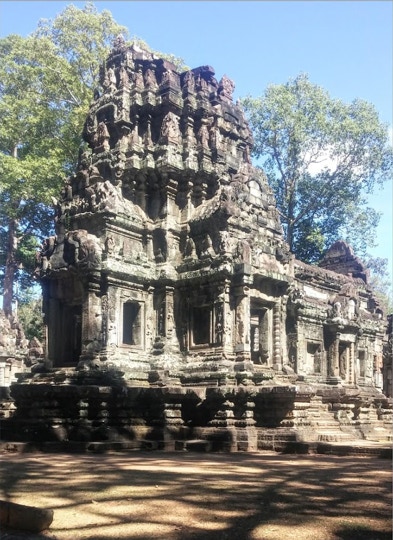
CHAU SAY TEVODA
(1113 – 1150)
SOUTH FACE, CHAU SAY TEVODA (1113 – 1150)

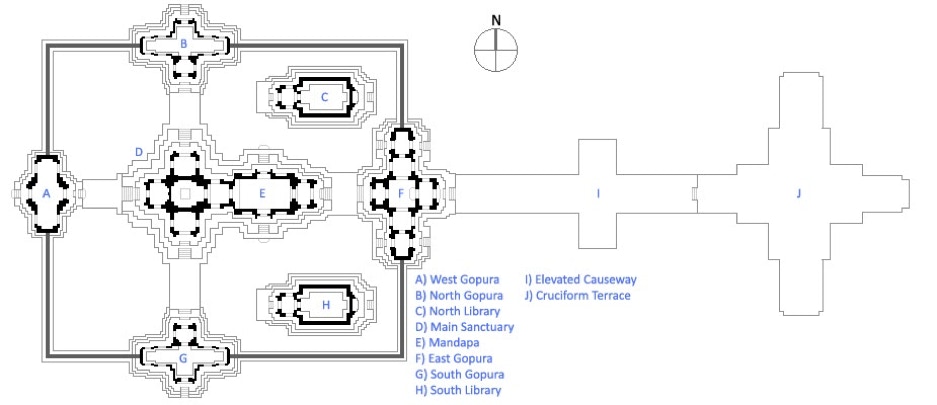
A. West Gopura
B. North Gopura
C. North Library
D. Main Sanctuary
E. Mandapa
F. East Gopura
G. South Gopura
H. South Library
I. Elevated Causway
J. Cruciform Terrace
SITE PLAN, CHAU SAY TEVODA (1113-1150)
The site plan of Chau Say Tevoda, constructed as much as forty years later than Thommanon, can be read not just as duplicating but completing and rationalizing the original plan of the earlier unfinished temple. It would have been less trouble to finish what was already started but Khmer temple construction was not so much functional as commemorative, monuments to their sponsor's power and piety which would hasten his path to moksha. Therefore the differences between these two temples might reveal something about their architectural objectives. The site plan shows several variations within substantial uniformity: 1) a northern gopura (B) matched by a gopura on the south (G) making a full complement of four; 2) the canonical, two libraries (C, H;) 3) a combined antarala and garbagriha’s eastern porch, a simplification of Thommanon's design, sacrificing the symmetry between the east and west porches of the sanctuary and the vestibules at either end of the mandapa for fusion and overlap; 4) consolidation of the three chambers of Thommanon's western gopura into a single redented, oblong space (A) like its north and south gopuras (B, G) but lacking they separate, inward-facing porches.; 5) the liturgical axis has been paved here from east to west as has the transverse north-south axis; 6) the moldings of the high jagati have been simplified from Thommanon's heavily incised courses.
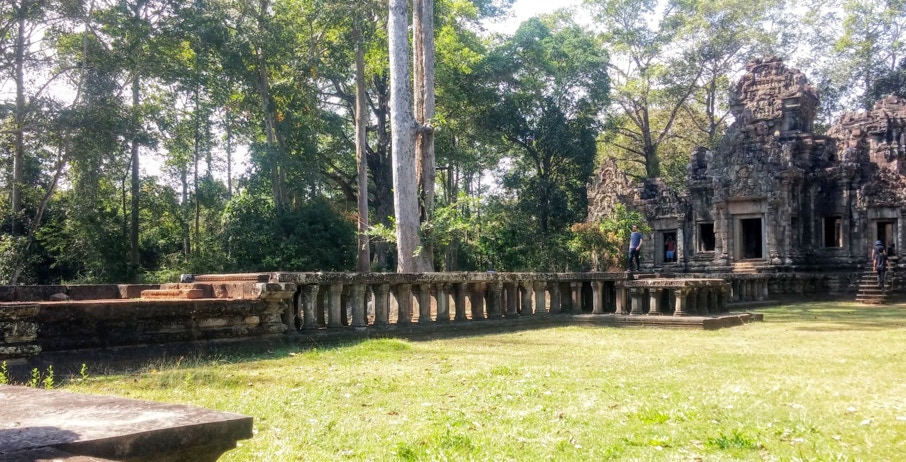
CAUSEWAY, CHAU SAY TEVODA (1113- 1150)
The most noticeable difference between the two site plans, however, is 7) the large terrace (J) and long causeway (I) with medial platform or terrace which leading to the 1st east gopura (F.) The closest parallels might be the causeway across the 4th enclosure at the Baphuon and Angkor Wat.p. The causeway originally led from a now-dry channel of the Siem Reap River, just below the Spean Thma or "stone bridge" (pictured at the base of this page,) like the western causeway from the East Baray at Banteay Samre. This might suggest that the most distinguished visitors to these temples preferred to travel by water through the extensive network of canals at Angkor, revealed recently by LIDAR imaging. The 1st east gopura, is visible on the right in the photograph above with its five lateral, staggered shala chambers and axial single shala roof.
This compact library at right can illustrate features shared by temples of the "Phimai Type." The first story, with the exception of the pilasters, colonettes and "blind" ("false," stone) doors is left as plain as possible, perhaps to set off the three pediments of the superstructure, teeming bas reliefs with snaking garlands, foliate fringe and now-obscure tympanums. Even in their dilapidated state, one can make out dancing apsaras at the base and above a god on a long-necked mount – Brahma's hamsa, Sarswati's swan or Skanda’s peacock. Above that a kala grins - or is it Rahu, the eclipse, licking his lips from having just swallowed the sphere of the sun below him, while in the upper pediment’s apex a god sits in a niche, presumably Shiva, a cave whose outward profile parallels Mt. Meru’s.
The lowest of the three pediments erupts into the aedicular story above the porch and portal; behind it, the middle rises from the eaves above the aisles, wide as the library's nave with the profile of a split panjara, or gavaksha, the characteristic, Khmer trefoil torana. Adam Hardy has argued that the separation of a panjara into two levels and widths, corresponding with a chaitya's cave's nave and aisles, demonstrates the dynamic of "emergent expansion" and a possible origin for the split gavaksha meshes covering so many Nagara (Northern India) shikharas. If so, the same dynamic might account for the separation of Khmer pediments into a continuous, rounded apex cusp and two open or parenthetic cusps below forming two registers especially appropriate for scenes linking earth and heaven. Together with the library's nave below they constitute two-story Dravida valabhi aedicule, a cusped shala alpa vimana above a rectangular ground story. In the photograph at right, the lower pediment, r could be read as the center of a double split gavaksha, the eaves forming the outer pair and middle pediment the inner pair around it. pediment, forming a larger, tripartite pediment stretching across the library's aisles and nave.
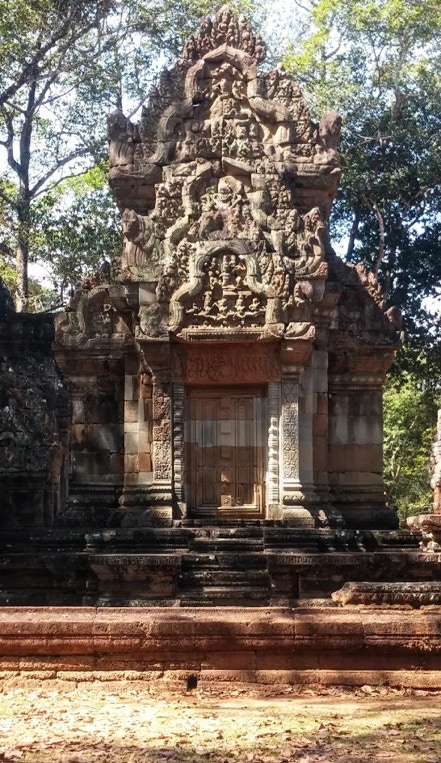
SOUTH LIBRARY, CHAU SAY TEVODA (1113 -1150)
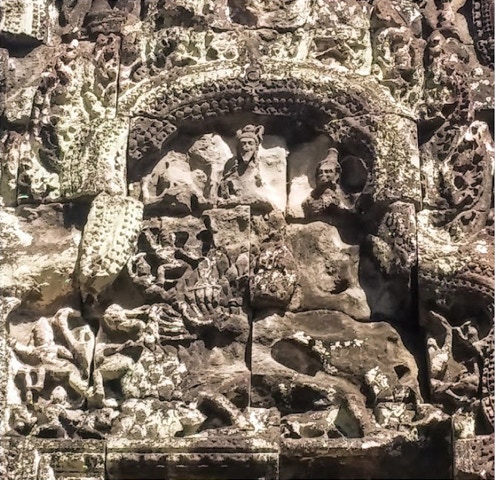
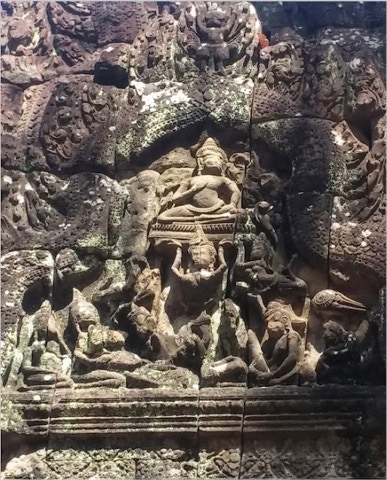
PEDIMENT, NORTH LIBRARY, CHAU SAY TEVODA (1113 - 1150)
This pediment from the north library at Chau Say Tevoda depicts the 20-armed demon, Ravana, shaking Mt. Kailasa, Shiva's mountain retreat, to attract the god's attention, terrifying its other inhabitants. Shiva, unperturbed at the center of the upper register, crushes Ravana simply by pressing down a finger. Ravana will than perform heroic penances and be reconciled with Shiva who grants him exceptional powers with which he proceeds to tyrannize India. This requires Vishnu, as the guarantor of dharma and just rule - in a sense, the opposite of Shiva's impulsive, alternately Dionysian and ascetic nature - to descend as his eighth avatar, Rama, to vanquish Ravana and restore the rightful order to human affairs. This episode therefore might be interpreted as the origin of the plot which propels the Ramayana, Ravana's use of the superhuman powers given him by Shiva to abduct Rama's wife, Sita, and wage the battle of Lanka, the climax of the epic.
PEDIMENT, 1ST NORTH GOPURA, CHAU SAY TEVODA (1113 -1150)
This pediment also shows a scene from the Ramayana - the triumph of the monkey king, Sugriva, over his brother, Valin, who has exiled him and married his wife (though she had originally been Valin's whom Sugriva married mistakenly thinking Valin dead.) Sugriva thumps himself on the chest in simian fashion on a throne symbolically supported by apsaras and a human, Rama, since it was he, hiding in the bushes, whose arrow actually killed Valin, fulfilling his pact of mutual assistance with the monkey king. The monkey army, headed by Hanuman, is a decisive factor in Rama's victory and recovery of Sita. Valin, who had some reason to think himself aggrieved, is mourned by some female monkeys at the left, including his wife whom Sugriva had married On the right, a monkey soldier wields a battle axe, though they are usually portrayed using only their paws and branches, signs of their more primitive civilization than the “more human” Aryans. At the very top, above the torana arch, Garuda, Vishnu's bird-man mount, vehicle or Gahanna stands in his usual Atlas-like posture which here repeats Rama's gesture below. The episode underlines the epic's central concern: the legitimacy of inherited authority within a feudal society.
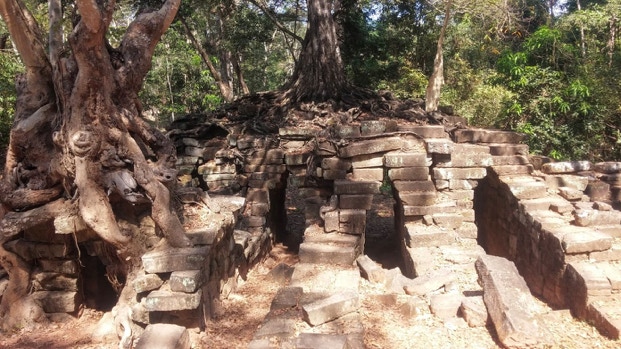
SPEAM THAN (16TH CENTURY)
Just after passing Thommanon and Chau Say Tevoda the road from the Victory Gate of Angkor Thom to Ta Keo passes this bridge spanning a now-dry tributary of the Siem Reap River (since canalized to the east) from which the causeway (I,J) led to Chau Say Tevoda. The bridge originally had fourteen arches but has been crunched by the aptly named strangler figs which have undermined the structural integrity of so many Angkorian monuments. Recent spectroscopic analysis has established that the finished blocks of stone with which the bridge was constructed were quarried at the same time and from the same place as the largely missing 1st gallery of the Bayon (1181-1120,) leading to the strong suspicion they had been spoil use to build the bridge. Later generations have often pillaged forgotten monuments for the seemingly more urgent purposes of the present, as was the case with the reclining Buddha at the Baphuon made from that temple's own tower. Similarly, papal irreverence for pagan Roman ruins led popes to build their family palaces with ashlars from the Colosseum and the Forum; the Palazzo Barberini, for example, was the target of a famous pasquinade: "Quod non fecerunt barbari, fecerunt Barberini."
64